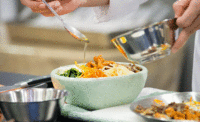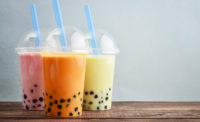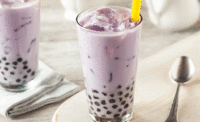Coffee Extract, Topping, and Flavor Trends
Cold beverages with foundations of coffee and tea continue to gain popularity on store menus and retail shelves

Specialty brewed coffees, such as the popular nitro coffee, are getting a flavor and health boost from fruit and floral botanicals.
PHOTO COURTESY OF: Florida Food Products, LLC
(Part 1 of a 2-part series)
No matter how one likes their coffee beverage, the time is ripe with opportunity for dressing it up with extracts, toppings, and flavors. Whipped, infused, boozed, and other indulgent categories are ready to be developed, and enjoyed by consumers of every demographic.
With more consumers choosing to prepare their daily ritual beverages at home, the usage of coffee in single serve cups, specialty coffee bean delivery services, and beverage “kits” for flavored cold coffee beverages has grown. In addition, there also has been a resurgence in the consumption of instant coffee, with more premium types of brew and more exotic flavorants employed.
After having slowly fallen in esteem to a seeming low-grade coffee product, instant coffee recently was supercharged via social media and the spread of viral videos. One premier example is the dalgona coffee craze. Dalgona is a Korean-style drink in which powdered coffee is beaten with confectioners’ sugar and hot water until it becomes creamy, then is spooned onto milk (hot or cold) and garnished with toppings. Typical toppings range from extra coffee powder or cocoa to cookie crumbles or drizzled honey.
Transferring the popular product to mass production, companies such as Java Nova Co. launched whipped coffee in a pressurized canister (a la whipped cream) to provide consumers all of the hipness and none of the preparation.
You can do it
Speaking of foams, cold foams are in greater demand than ever as coffee toppers. They allow both consumers and foodservice operators to add fun, flavor, and color to coffee drinks. Even more in tune with consumers’ demands, such foams are acting as vehicles for functional ingredients. Canisters of these specialty beverage differentiators also are prized for their space-saving capacity and ease of use.One company taking successful advantage of this is Over the Top Foods, Inc.’s WhipNotics brand. The company makes whipped toppings with fruit and confection flavors that can be natural companions to coffee beverages. “The dessert category should influence seasonal cold brew beverages boasting flavor profiles such as Bananas Foster or peach cobbler,” notes Michael Bongiornio, Sr., corporate executive chef for Golden State Foods, Inc.
Bongiornio notes that dessert frappe and latte drinks topped with whipped cream cheese, matcha, turmeric-ginger cream, and even salted cheese are ready to appeal to today’s more engaged coffee consumer. He also recommends inclusions of brown sugar or flavor-popping boba, or green tea jelly. Such next-generation drinkable dessert coffees can be enticing and eye-catching.
In the mood
Whether the desire is reduced mental and physical stress, lowered anxiety, or a boost of energy and concentration, CBD and functional nootropic ingredients are key components in the concurrent growing trends of coffee substitutes and replacements for dairy creamers. Ingredients such as medicinal mushrooms and botanicals are finding success in both.A number of mushroom “coffee” makers have sprung up of late, and infused creamers are evident in products by Clover Sonoma Dairy Co., specifically its “Moon Milks” line in Blue (blueberry lavender), Pink (cherry-berry hibiscus), and Golden (turmeric-ginger). A similar line is now offered by plant milk maker Good Mylk Co. Its “activated creamers” offerings are available in oat or almond and contain tocotrienol vitamin E, extracts of reishi and lion’s mane mushrooms, and the botanicals Astragalus propinquus and turmeric.
The big food companies are not ignoring this “better-for-you coffee” wake-up call. Nestlé NA recently launched its “Boosted Brew” line of what it terms “coffee enhancers,” such as its “Keto Coffee” take on the popular butter coffee craze of a few years ago. The Nestlé version is a stir-in creamer that includes MCT oil and dairy butter, touted for energy and increased metabolism. The company also launched a separate keto creamer and a keto coffee. Lightly sweetened with allulose, it also avoids bitterness and off flavors that can come with other coffee enhancer products.
Developing such beverages using indulgent flavors, and even mixed with wellness ingredients, offers consumers a more digestible approach to trying new products. In coffee, they allow for less fear of disappointment and risk. Coffee beverages are the perfect vehicles because of coffee’s familiarity, clean energy, and the multiple consumption occasions in which it can be enjoyed.
Eric Nakata is an experienced creative brand strategist driving results through innovation and product development for more than two decades. He is the Chief Executive for En-voke, LLC., a business development company working with food, beverage, and CBD companies. Previously, he served as VP of Innovation for S&D Coffee and Tea, Inc.; Newly Weds Foods, Inc.’s strategic development chef for McDonald’s Corporation; Director of R&D for Mont Blanc Gourmet; and senior corporate innovation chef for Nestlé NA. You may reach him directly at enakata.envoke@gmail.com.
A Taste for Coffee
No matter the weather, time of year, or day part, coffee consumption by both young and older consumers continues to increase the demand for cold coffee products. Luckily for beverage developers, such products provide an innovation playground. With its ease of use and reduced bitterness, cold coffee concentrates and green coffee bean extract are finding their way into yogurts, ice creams, and confections while lending approachability to confections, wellness crossovers, savory items, and even more exotic trend-forward flavor combinations.Fruits and flowers
With summer under way, the season’s fruit flavors are in play. Watermelon is promising to be a popular summer flavor, already showing up in sparkling green coffee extract beverages. Coffee beverages also are finding themselves paired with other fruits, ranging from the tropical— banana, mango, and pineapple—to the red and purple superfruits, especially blueberries, strawberries, cherries, blackberries, and pomegranate. Citrus, too, is pairing with other flavors to add brightness and fruity astringency to balance the earthiness of the roasted bean foundation. These complimentary partners find their sweet spot as they supply color, flavor, and comfort that brings consumers something new yet familiar. For the more daring palate, coffee beverages also are ready to dance with jalapeño and tajin-inspired flavors this year. Floral flavors, too, are finding their way into coffee, with such additions as hibiscus, elderflower and lavender.No hard cell
Cell-based meat and precision-fermented dairy are now a reality. Yet for several decades, the idea of cell-based coffee was equally intriguing to some scientists. Then, last fall, a team of researchers at the VTT Technical Research Centre in Tampere, Finland succeeded in brewing a cup of cell-based joe. Created in the same way as other cell-based products, the coffee cell lines are grown and then cultivated into biomass in nutrient-infused bioreactors. With coffee shortages anticipated to occur in the next couple of decades due to climate shifts, the idea is that lab-grown coffee cells, which proved in the VTT experiments to have the flavor and aroma of naturally grown coffee when the biomass was dried, roasted, and brewed, can fill the need. It was also noted that cell-based plant cultivation is far less costly than cultivating cell-based animal protein.This coffee trend doesn’t suck
Vacuum siphoned coffee, a 200-year-old technique, is making a big—and sophisticated—comeback thanks to modern technology. The combination of a vacuum that draws the volatile flavors and aroma from the beans and steam that gently brews the coffee is said to deliver smooth, crisp and clean flavors while preserving the rich toasted bean notes and full body of the coffee’s natural aromatic oils. While coffee shops and other retail outlets will likely start adopting siphoned coffee in the coming months, expect beverage makers to begin offering the beverage in bottles and cans in the next year or so.Looking for a reprint of this article?
From high-res PDFs to custom plaques, order your copy today!





